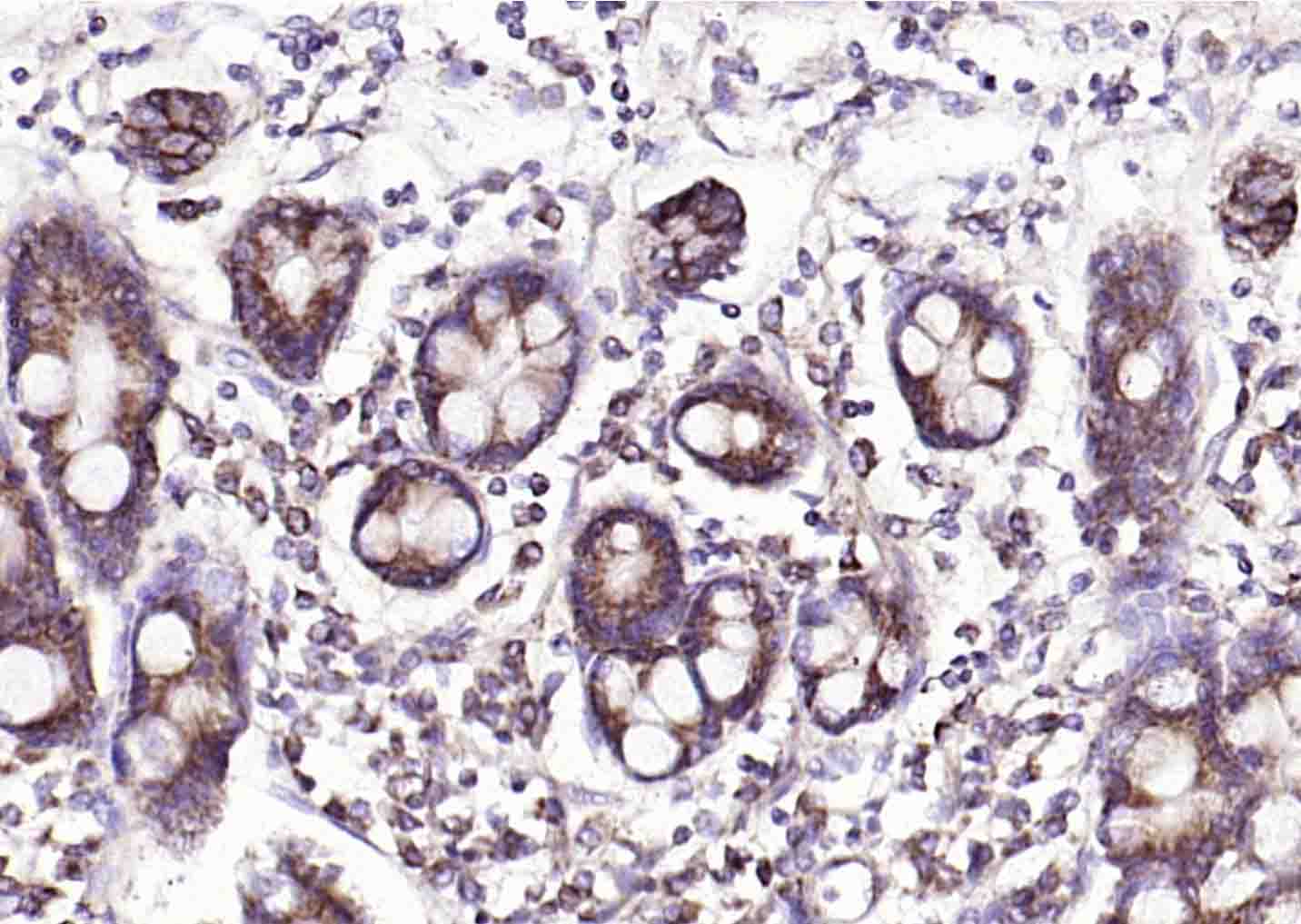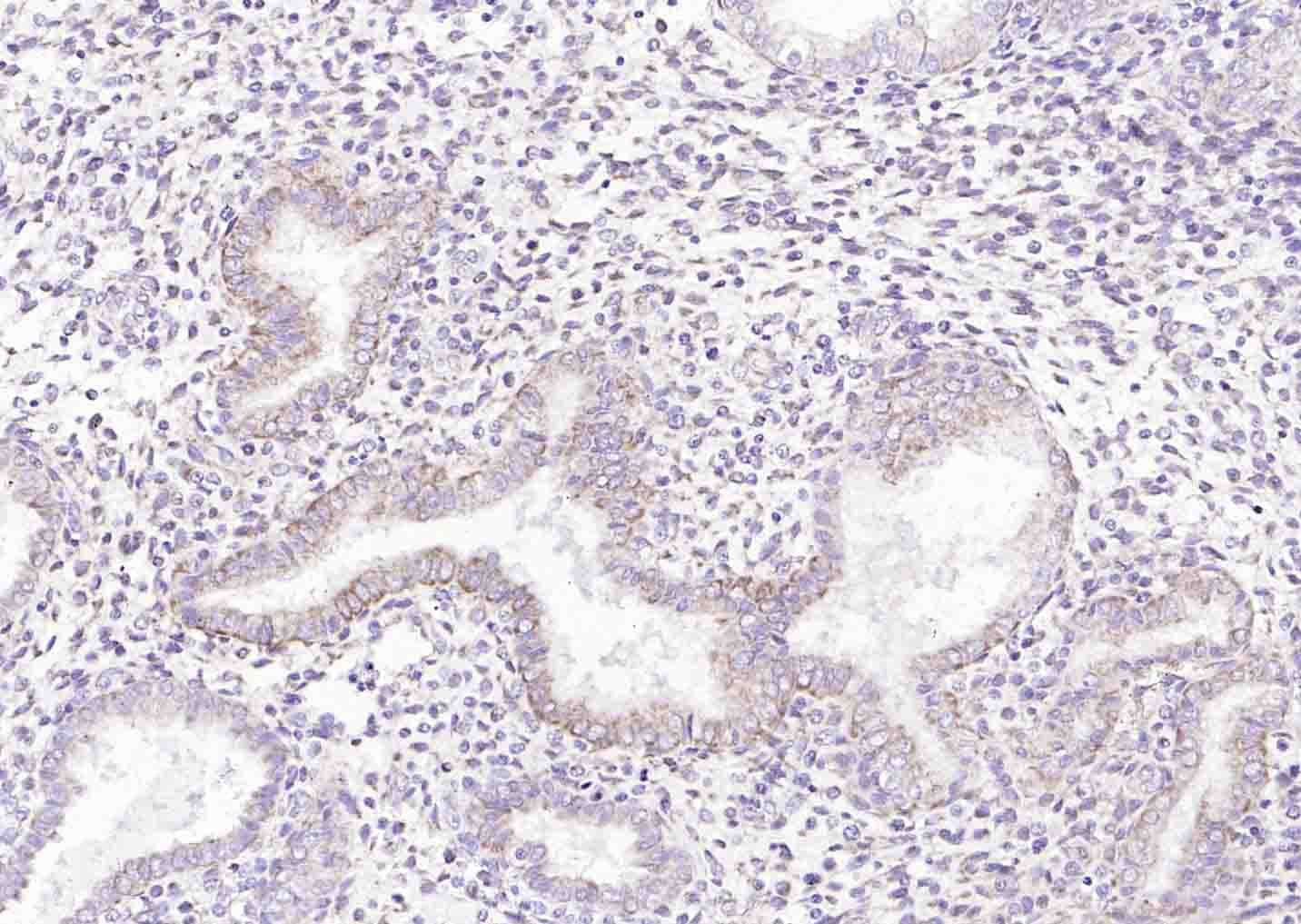Defensin alpha 5 Rabbit pAb
Defensin alpha 5 Rabbit pAb
- 产品详情
- 实验流程
- 背景知识
Application
| IHC-P, IHC-F, IF |
|---|---|
| Primary Accession | Q01523 |
| Reactivity | Human |
| Host | Rabbit |
| Clonality | Polyclonal |
| Calculated MW | 10071 Da |
| Physical State | Liquid |
| Immunogen | KLH conjugated synthetic peptide derived from human Defensin alpha 5 |
| Epitope Specificity | 31-94/94 |
| Isotype | IgG |
| Purity | affinity purified by Protein A |
| Buffer | 0.01M TBS (pH7.4) with 1% BSA, 0.02% Proclin300 and 50% Glycerol. |
| SUBCELLULAR LOCATION | Secreted. Cytoplasmic vesicle > secretory vesicle. Peptides HD5(20-94), HD5(23-94) and HD5(29-94) are found within tissues, HD5(20-94) being the predominant intracellular form. Peptides HD5(56-94) and HD5(63-94) are found in the extracellular milieu, HD5(63-94) being the most abundant form. |
| SIMILARITY | Belongs to the alpha-defensin family. |
| Post-translational modifications | Glycosylated. |
| Important Note | This product as supplied is intended for research use only, not for use in human, therapeutic or diagnostic applications. |
| Background Descriptions | Has antimicrobial activity against Gram-negative and Gram-positive bacteria. Defensins are thought to kill microbes by permeabilizing their plasma membrane. All DEFA5 peptides exert antimicrobial activities, but their potency is affected by peptide processing. |
| Gene ID | 1670 |
|---|---|
| Other Names | Defensin alpha 5 {ECO:0000312|HGNC:HGNC:2764}, Defensin-5, HD5(20-94), HD5(23-94), HD5(29-94), HD5(56-94), HD5(63-94), DEFA5, DEF5 |
| Target/Specificity | Paneth cells of the small intestine (at protein level). |
| Dilution | IHC-P=1:100-500,IHC-F=1:100-500,IF=1:100-500 |
| Format | 0.01M TBS(pH7.4) with 1% BSA, 0.09% (W/V) sodium azide and 50% Glyce |
| Storage | Store at -20 °C for one year. Avoid repeated freeze/thaw cycles. When reconstituted in sterile pH 7.4 0.01M PBS or diluent of antibody the antibody is stable for at least two weeks at 2-4 °C. |
| Name | DEFA5 |
|---|---|
| Synonyms | DEF5 |
| Function | Host-defense peptide that maintains sterility in the urogenital system (PubMed:12021776, PubMed:12660734, PubMed:15616305, PubMed:19589339, PubMed:22359618, PubMed:22573326, PubMed:25354318, PubMed:25782105, PubMed:30808760). Has antimicrobial activity against a wide range of bacteria, including Gram-negative E.coli, P.aeruginosa and S.typhimurium, and Gram-positive E.aerogenes, S.aureus, B.cereus, E.faecium and L.monocytogenes (PubMed:12021776, PubMed:15616305, PubMed:19589339, PubMed:22359618, PubMed:22573326, PubMed:25354318, PubMed:30808760). Confers resistance to intestinal infection by S.typhimurium (PubMed:12660734). Exhibits antimicrobial activity against enteric commensal bacteria such as B.adolescentis, L.acidophilus, B.breve, L.fermentum, B.longum and S.thermophilus (PubMed:25354318). Binds to bacterial membranes and causes membrane disintegration (PubMed:25782105). Induces the secretion of the chemokine IL-8 by intestinal epithelial cells (PubMed:19589339). Binds to B.antracis lef/lethal factor, a major virulence factor from B.anthracis, and neutralizes its enzymatic activity (PubMed:22573326). |
| Cellular Location | Secreted. Cytoplasmic vesicle, secretory vesicle. Note=Stored as propeptide HD5(20-94) in secretory granules of small intestinal Paneth cells and found in the ileum lumen as processed mature peptides, predominantly in the HD5(63-94) form (PubMed:12021776). Peptides HD5(20-94), HD5(23-94) and HD5(29-94) are found within tissues, HD5(20- 94) being the predominant intracellular form. Peptides HD5(56-94) and HD5(63-94) are found in the extracellular milieu, HD5(63-94) being the most abundant form (PubMed:12021776). Secreted into the female genital tract lumen (PubMed:9588893). |
| Tissue Location | Expressed in the gastrointestinal, reproductive, and urinary tracts (at protein level) (PubMed:12021776, PubMed:1429669, PubMed:22359618, PubMed:9588893). Expressed in Paneth cells of the small intestine (at protein level) (PubMed:12021776, PubMed:1429669) Expressed throughout the urothelium of the lower urinary tract and in the collecting tubules of the kidney (at protein level) (PubMed:22359618). Expressed in stratified squamous epithelial cells of the female genital tract epithelia, such as in vagina, ectocervix, endocervix, endometrium, and fallopian tube (at protein level) (PubMed:9588893). Endometrial expression correlates with stages of the menstrual cycle: Expression is low during the early proliferative phase, increased during the mid- to late proliferative phase, peaks during the early secretory phase of the cycle, and decreases during the mid- to late secretory phase (PubMed:9588893) |
Research Areas
For Research Use Only. Not For Use In Diagnostic Procedures.
Application Protocols
Provided below are standard protocols that you may find useful for product applications.
BACKGROUND
This product as supplied is intended for research use only, not for use in human, therapeutic or diagnostic applications.
终于等到您。ABCEPTA(百远生物)抗体产品。
点击下方“我要评价 ”按钮提交您的反馈信息,您的反馈和评价是我们最宝贵的财富之一,
我们将在1-3个工作日内处理您的反馈信息。
如有疑问,联系:0512-88856768 tech-china@abcepta.com.























 癌症的基本特征包括细胞增殖、血管生成、迁移、凋亡逃避机制和细胞永生等。找到癌症发生过程中这些通路的关键标记物和对应的抗体用于检测至关重要。
癌症的基本特征包括细胞增殖、血管生成、迁移、凋亡逃避机制和细胞永生等。找到癌症发生过程中这些通路的关键标记物和对应的抗体用于检测至关重要。 为您推荐一个泛素化位点预测神器——泛素化分析工具,可以为您的蛋白的泛素化位点作出预测和评分。
为您推荐一个泛素化位点预测神器——泛素化分析工具,可以为您的蛋白的泛素化位点作出预测和评分。 细胞自噬受体图形绘图工具为你的蛋白的细胞受体结合位点作出预测和评分,识别结合到自噬通路中的蛋白是非常重要的,便于让我们理解自噬在正常生理、病理过程中的作用,如发育、细胞分化、神经退化性疾病、压力条件下、感染和癌症。
细胞自噬受体图形绘图工具为你的蛋白的细胞受体结合位点作出预测和评分,识别结合到自噬通路中的蛋白是非常重要的,便于让我们理解自噬在正常生理、病理过程中的作用,如发育、细胞分化、神经退化性疾病、压力条件下、感染和癌症。







